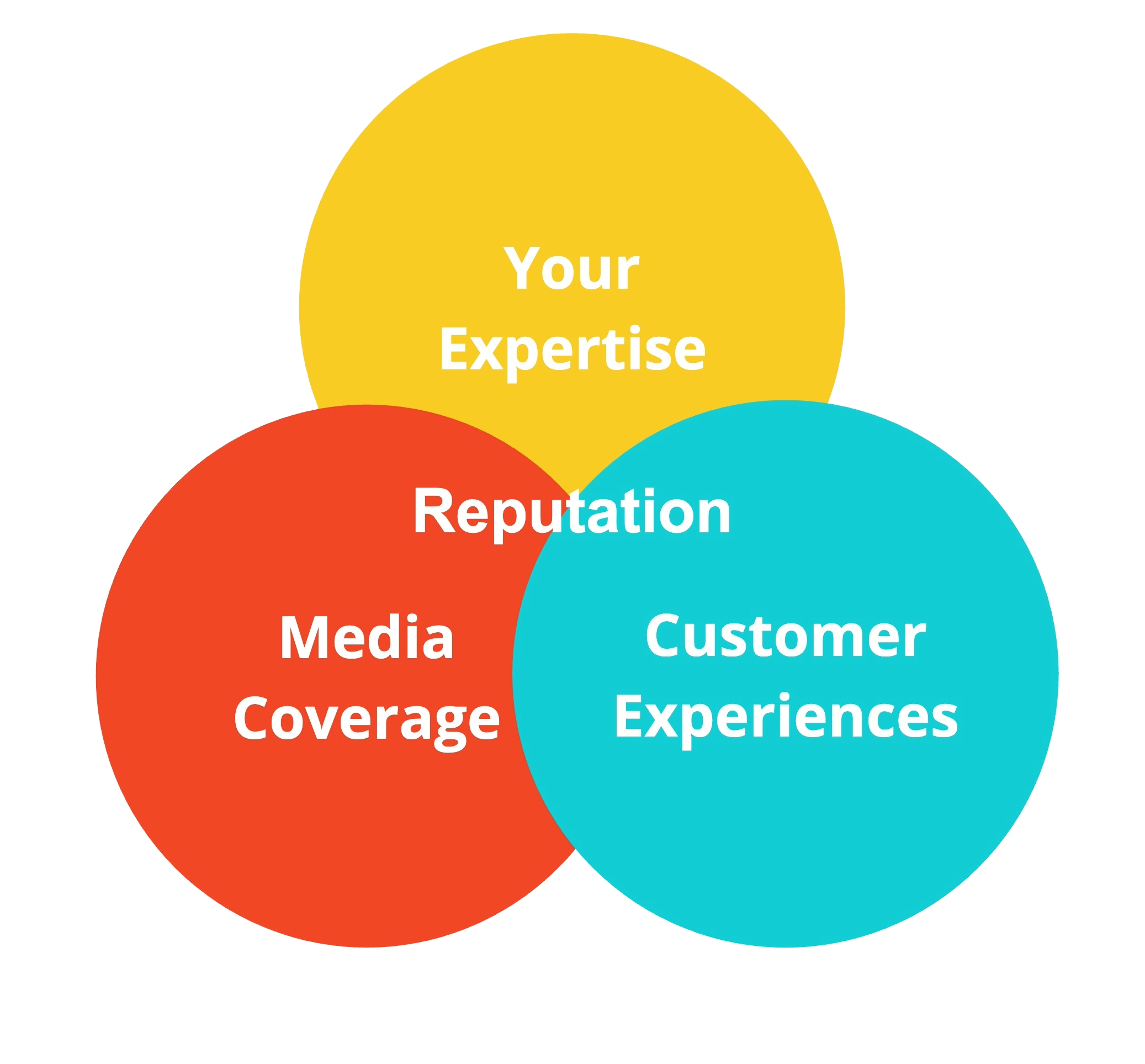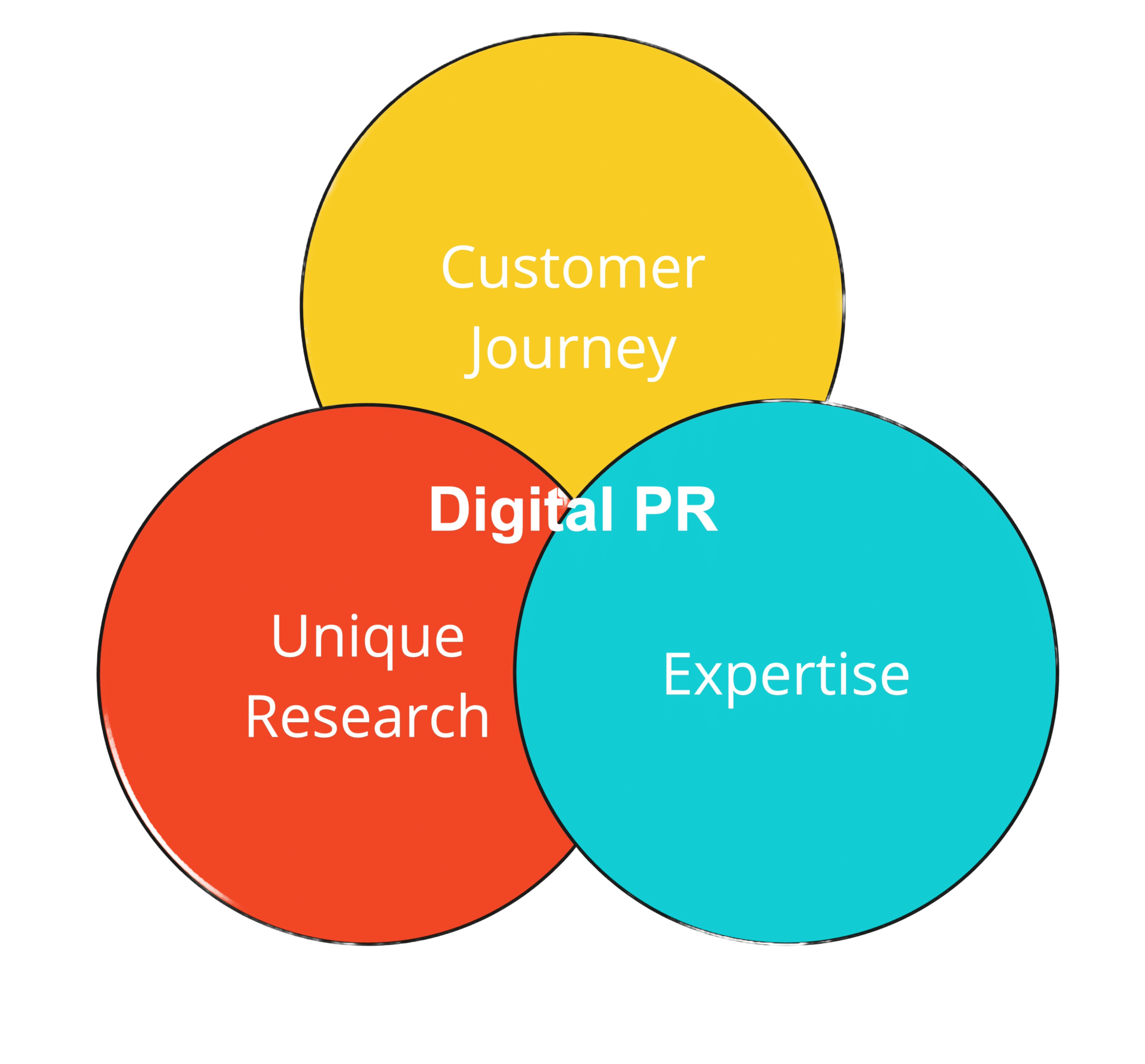PR Link Building
What is it, How it works.
What is Digital PR link building?
It’s a link building alternative
PR link building, also called “digital PR link building,” is an alternative to traditional link building strategies that earns links and mentions to improve a site’s reputation with search engines.
The most common techniques are data campaigns, expert commentary & reactive PR.
The strategy secures links or brand mentions from the press, blogs, podcasts, and social communities.
Why It’s Trending
Digital marketers and SEOs are switching to digital PR link building from traditional link building to improve site reputation and not just build a link profile for authority.
- Google’s Approval
- Reputation
- Improved AI
Google has been consistent in its stance that SEOs should market the site, product/services, content, and people behind it and earn links as a result of appealing to an audience.
I love some of the things I see from digital pr, it's a shame it often gets bucketed with the spammy kind of link building. It's just as critical as tech SEO, probably more so in many cases.
— John (@JohnMu) January 23, 2021
Google’s algorithm is heavily influenced by the reputation of a site and its content. The Search Quality Evaluator Guidelines clearly states:
An important part of PQ rating is understanding the reputation of the website. If the website is not the primary creator of the MC, it’s important to research the reputation of the content creator as well.
Google’s AI has advanced the factors that improve ranking and how it understands a brand/entity’s reputation.
Google’s demonstrated how powerful its AI models are with Gemini, showing that the AI can understand some important aspects of reputation:
- Who creates the content
- What is their expertise
- What are other’s saying about the company, product/services, or people
Search Engine Reputation?
Google’s ranking algorithm, often referred to as PageRank in its initial forms, has evolved significantly over the years to incorporate a wide array of factors beyond the basic principle of “link analysis” for determining the relevance and ranking of web pages. While Google’s exact algorithm is proprietary and not publicly disclosed in detail, it is known that the concept of “reputation” plays a crucial role in how pages are ranked in search results.

Search engine reputation refers to the perception of a website or web page’s quality, reliability, and authority as evaluated by search engines, which in turn influences its visibility and ranking in search engine results pages (SERPs).
It’s a field of expertise: Reputation relates to an individual or company’s specific field or area of expertise. A site, company or individual can have a strong reputation in one area but not as strong in another. How broad and deep your experience and knowledge are in that area improves your expertise.
It’s proof of expertise: What proof does the individual or company have of their expertise in a real-world application? These can include customer stories, case studies, research, or testimonials.
It’s influence: When experts, journalists, content creators, or customers share your content, product, research, or company, this is a signal of influence.
It’s for an audience: A reputation is in the eye of the beholder. Your expertise will be relevant to a certain audience, and your content will be more relevant to one audience than another. If the audience talks about or includes your product, content, research, company, or ideas, then this will impact your reputation.
Google uses AI: Google’s use of AI in its algorithm to go beyond simple link signals to develop a more holistic understanding of a site’s reputation when ranking it’s content.
Visibility and traffic: Websites with a strong reputation tend to rank higher in search results, leading to increased visibility and organic traffic.
Resilience to algorithm updates: Google frequently updates its algorithms to improve search quality and user experience. Sites with a solid reputation are more likely to maintain or improve their rankings following such updates, whereas sites with poor reputations may suffer drops in rankings.
Popular Techniques to improve reputations include:
- Data campaigns form unique research
- Reactive PR
- Inbound PR
- Expert commentary for journalists
Digital PR vs Link Building
PR and traditional link building are similar in some ways but very different in others.
Although links are an important part of a campaign, links are not the only thing that impacts a site’s reputation or ranking in a world of aI.
The two strategies are different in the output, ways of selecting sites, techniques used, and media types.
- Creation of
- Selecting Sites
- Techniques
- Media
Link building
- Mainly links: Link building only focused on links because it was the main ranking factor.
- Dofollow/nofollow links: Links that didn’t have a nofollow tag
Digital PR
- Brand mentions: Mentions of the company, people, products/services, and content (e.g. branded research reports).
- Customer stories: Customers talking about how they use the product.
- Thought leadership: Internal experts sharing their knowledge on the subject to show EEAT.
- Reputation: A specific area of expertise in an audience that discusses it.
- Unique research: Shares of studies, surveys, or other unique data
- Relevant storylines: Topically relevant articles that relate to the customer or product.
Link building
- Domain rating/authority: Using tools like Ahrefs, Moz, Majestic, or SEMrush for website metrics that are based on the site’s ranking.
- Link quality: Measures of quality like wordcount or site design.
- Keyword ranking: Does the site rank for related keywords?
- Traffic: How much traffic does the site get from Google or in general
Digital PR
- Brand traffic: The amount of searches for the site’s brand name.
- Audience relevance: Does the target audience visit the site or podcast?
- Story relevance: The topic relevance of the story to the company, product or customers.
- Customer journey: What touchpoints are relevant to the customer on their journey to buy your product and solve their problems?
Link building
- Link inserts: Ask for a link to be inserted into an article
- Niche edits: Similar to link inserts but for niche-specific blogs.
- Broken links: Search for any broken link and ask for an update to your content.
- Guest posts: Contribute an article to a site either by your name or personas.
- Competitor links: Go after links just because they also link to a competitor.
Digital PR
- Reactive PR: Company or internal experts react to trending stories
- Data campaigns: Unique research and insights that journalists can use in their stories.
- Expert commentary: Experts provide commentary, direction, or insights to journalists for their stories.
- Inbound PR: Optimize unique research or data to be found by journalists.
- Passive PR: Monitor journalist’s request for sources or insights on a specific story.
Link building:
- Niche blogs: Blogs that are about a specific topic but might not have a relevant audience.
- Lifestyle sites: Sites that cover a wide range of topics related to the target keyword.
- Any site blogs: Blogs of any sites that will accept a link or guest posts.
Digital PR:
- Audience-specific blogs: Blogs on sites that the audience will read.
- Press: News sites in the market or where the audience is.
- Podcasts: Become a guest on a podcast or be mentioned on them.
- Social: A small but growing part of SEO is customer engagement and discussion on social.
- Industry/audience-specific sites: Sites that create content for a specific audience.
How PR Link Building Works

Overview
Digital PR link building works by creating a unique company asset around a trending topic in the news and pithing the story to journalists, editors or content creators. Then customize the storyline to a journalist or outlets content or angles they typically have on a given topic.
Using unique research, expertise, customer stories, or interesting product launches will entice journalist to include a link or brand mention in the content.
Assets generates the best response rates and coverage are unique research or expert commentary on trending topics.
Top Techniques
- Data Campaigns
- Reactive PR
- Expert Commentary
- Thought Leadership
- Inbound PR
Create unique research from surveys, web crawls or publicly available datasets. Create visual graphs, charts, or infographics from the data to share with journalists, pitching the research in the context of trending storylines or topics.
The media will link to the research page, quote an internal expert, and mention the report or the company’s brand name.
PureLinq specializes in data campaigns
Reactive PR refers to a public relations technique where businesses or individuals respond to external events, trends, media inquiries, or public discussions rather than initiating them.
This approach can involve addressing emerging news stories, public concerns, social media trends, or events that impact the brand or its industry.
With this technique, PR leverages an internal expert or spokesperson to position themselves as an expert to provide expert opinion, analysis, or opinions on current trending topics.
This approach leverages the expertise of company leaders, professionals, or subject matter experts to engage with the media, stakeholders, and the public.
The objective is to enhance brand visibility, credibility and thought leadership by contributing valuable knowledge and perspectives to the conversation.
The audience then shares your content as a result.
Thought leadership is focused on leveraging internal experts as leading authorities in their respective fields to secure bylines, op-eds guest posts, or podcasts guest spots.
This method revolves around sharing innovative ideas, insightful analysis, and forward-thinking perspectives that address industry challenges, trends, and opportunities.
The audience then shares the piece or links from the post or podcast on social or in their content, including brand names.
Inbound PR is a unique technique that integrates SEO and PR by optimizing content specifically to be discovered by journalists, content creators, and media professionals when they’re seeking research, statistics, data, studies, or other authoritative content for their articles and stories.
The content is hosted on the website blog or in a unique page, and optimized for keywords related to journalists.
General Process
Identify expertise
Your company and individual topical area of expertise are at the center of your online & search engine reputation, and that is why the media will include your commentary and research.
Identify the areas that individuals or the company are experts in. These areas can come from individual experts, products/services, or technology.
Trend analysis
Analyze general industry or niche trends to identify the topics journalists or content creators are most interested in writing about.
- General trends: Use tools like Google Trends or MarketMuse to identify keywords that people are using and searching for more frequently.
- Conversation trends: What are journalists or social media users discussing more often in articles or on social?
Storyline
A storyline in digital PR pitching refers to a cohesive, compelling narrative constructed around data, events, products, or brand initiatives intended to capture the interest of journalists, bloggers, and influencers. Unlike traditional pitches that might directly promote a product or service, a storyline weaves together facts, insights, and angles into a narrative that offers value to the media and their audience, making it more likely to be picked up and covered.
Creating a compelling storyline involves identifying or creating a narrative that is relevant, timely, and engaging and that fits naturally within the context of current trends, news cycles, or public interests. The aim is to present your message in a way that resonates with the media outlet’s readership or viewership, providing them with content that is informative, entertaining, or enlightening.
Asset creation
Identify existing or create new content assets that can be helpful to journalists or content creators.
These Digital PR assets are helpful to secure links and mentions:
- Expert profiles: Internal experts and how their expertise relates to the trending stories or topics.
- Public data analysis: Identify unique insights about the trending topics and turn them into visually interesting assets.
- Audience surveys: Run surveys with an email list or panel networks, like SurveyMonkey’s market research product.
- Press releases: Write the story in a standard format that journalists use.
- Email pitch templates: Create email templates that are unique to the trending topics but easy to customize for the specific publication or journalist.
- Data/research graphics: Turn the data into easily digestible graphs, charts, tables, or infographics that journalists can use to tell their story.
Unique data, research, or expert commentary are techniques that are most likely to convince the author to include a link.
Media List Building & Monitoring
List building in PR link building is a method to monitor and identify journalists, editors, content creators, or media proactively or reactively.
The list building process is different based on the type of campaign:
- Reactive PR: Sometimes called newsjacking or trendjacking, build a reactive campaign list by creating an initial list of media contacts. Then, monitor the news for trending stories related to the media contact’s topics or angles.
- Passive PR: Monitor sites like Qwoted or HARO for journalists’ requests for expert sources, tips, or questions.
- Thought leadership/Podcasts: Search for sites that accept contributors or podcast guests. Not all sites or podcasts will accept a guest.
- Expert commentary: Build a list of journalists or editors that cover a specific type of story or topic.
Use media databases like MuckRack or Prowly to find journalists, editors, and press media.
I find that Prowly’s database seems larger than MuckRack’s and has a month-to-month option.
A well-segmented and documented media list can distinguish between a very slow or rapid pitching process.
Custom Angles Pitching
Pitching angles to the media is a process of customizing the email so that the storyline, expert, research, or other asset is relevant to the journalist, editor, or media outlet’s topics or way of covering a topic.
This involves a careful balance between personalization and providing value to the asset.
Research the contact’s content and actually read or listen to it carefully. Identify the topics they cover, angles they take on a subject, how they/if they use data, and what they are currently covering. Look through the contact’s recent articles, social posts, stated interest and job title.
Placement Monitoring/Reporting
Active monitor of the brand name, topic, journalist, links, or other unique terms to identify when a placement has gone live.
Journalists won’t always reply to inform you that they have written an article or included your assets. They are busy and typically have other stories and interviews to move on to next.
PR link building methods
Media Relations
Direct outreach
Passive
PR
Inbound
PR
Where Links Point
PR links require media monitoring to find all of the secured links as a result of a campaign. Journalists will use your research or commentary but not notify you that it’s live. Journalists have limited resources and time, so they tend to move on to the next story quickly.
These links and mentions can be in 3 key areas:
- Company & homepage: links to the homepage or mentions of the general brand name
- Expert/leadership: Mentioning the names of experts or links to the bio pages or homepages.
- Research pages: Name of a branded study or research or links to the research pages around specific statistics, charts, or graphics.




